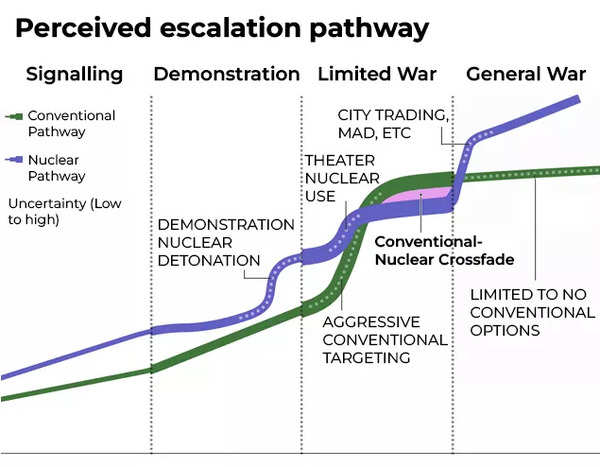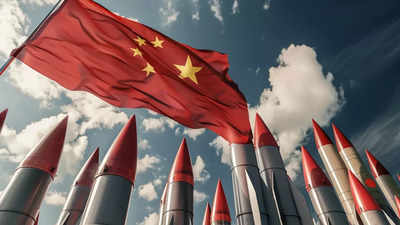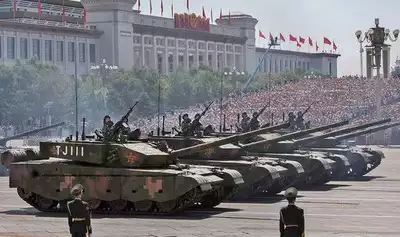- News
- World News
- US News
- US vs China: Who would win if war went nuclear?
Trending
US vs China: Who would win if war went nuclear?
The CNAS conducted a simulation forecasting a potential nuclear conflict between the US and China over Taiwan in 2032. The exercise indicated China might employ theater nuclear weapons to pressure the US. Recommendations include enhancing dialogue with China, reinforcing alliances, and improving US nuclear and conventional capabilities to manage escalation risks.
In a tabletop exercise conducted by the Centre for a New American Security (CNAS), a think-tank in Washington, experts explored the chilling scenario of a Sino-American nuclear war breaking out in the year 2032. The results of the wargame were sobering, highlighting the potential for a nuclear conflict to emerge from a conventional war over Taiwan, with devastating consequences.
The scenario posited that after 45 days of intense warfare over Taiwan, China might resort to using “theatre” nuclear weapons—shorter-range and lower-yield compared to the strategic nuclear missiles designed to target cities.
The authors - Andrew Metrick, Philip Sheers and Stacie Pettyjohn - employed two TTXs to explore the dynamics of nuclear coercion in a hypothetical 2032 conflict over Taiwan. The exercises, named "Spike the Ball" and "Cold Stop," tested different scenarios where China might use nuclear weapons to either consolidate a marginal advantage or compensate for a disadvantage. The results highlighted the complexity of managing nuclear escalation in such a conflict and the challenges facing US decision-makers.
US and Chinese nuclear capabilities
China, on the other hand, has traditionally maintained a smaller and more conservative nuclear force. However, recent years have seen a significant expansion and modernization of China's nuclear arsenal. China's development includes new mobile missile systems, enhancements to submarine-launched ballistic missiles, and the construction of numerous hardened ICBM silos. By 2030, China is expected to have around 1,000 operational nuclear warheads.
"China is expanding its nuclear arsenal faster than any other country. But in nearly all of the nuclear-armed states there are either plans or a significant push to increase nuclear forces," said Hans M Kristensen, an associate senior fellow with SIPRI.

Despite this growth, China’s nuclear doctrine historically emphasized a no-first-use policy and maintained a strategy focused on assured deterrence rather than nuclear warfighting. However, the expansion and modernization efforts suggest that China may be moving towards a more flexible and potentially more aggressive nuclear posture. This shift could involve adopting a launch-on-warning posture and integrating nonstrategic nuclear weapons into its conventional warfighting strategies .
Escalation pathways and potential outcomes
The potential pathways to nuclear escalation between the US and China are complex and fraught with risks. A key finding of the study is that a protracted conflict, particularly one involving a crisis over Taiwan, creates conditions where nonstrategic nuclear weapons use becomes increasingly appealing for China.
As conventional capabilities become strained, China might consider limited nuclear strikes, despite its formal “No First Use” policy, to achieve favorable terms or to coerce the US into de-escalating the conflict.

If China were to initiate limited nuclear strikes, especially against US military targets or allied territories in the Indo-Pacific, the US would face a critical decision point. The study’s tabletop exercises (TTXs) indicate that US decision-makers might struggle to respond uniformly to such provocations. Some might advocate for a proportional nuclear response, while others could argue that US interests in Taiwan do not justify the risks of further nuclear escalation .
The role of allies and global impact
Another critical factor in a US-China nuclear conflict is the role of US allies in the region. The study notes that China could use nuclear coercion against US allies, such as Japan or Australia, to weaken the US alliance network and strain its extended deterrence commitments. Such actions would not only challenge US resolve but also potentially fragment the alliance, making it more difficult for the US to maintain a unified front against Chinese aggression .
The global impact of a nuclear war between the US and China would be catastrophic, with consequences far beyond the immediate destruction caused by nuclear weapons. Economically, politically, and environmentally, the effects would be felt worldwide, making the very concept of "winning" in such a conflict meaningless.
"The political ramifications of nonstrategic nuclear use are highly variable and unpredictable. While there is a clear operational utility to nuclear arms, their political impacts are far less certain, resulting in a wide range of different beliefs within the expert community," the report notes.
Key findings and recommendations
The report concludes with several key findings and recommendations for US policymakers:
The scenario posited that after 45 days of intense warfare over Taiwan, China might resort to using “theatre” nuclear weapons—shorter-range and lower-yield compared to the strategic nuclear missiles designed to target cities.
These weapons could be used in an attempt to coerce the United States into submission by targeting key military assets such as Guam, Kwajalein Atoll, and an American aircraft carrier strike group.
The authors - Andrew Metrick, Philip Sheers and Stacie Pettyjohn - employed two TTXs to explore the dynamics of nuclear coercion in a hypothetical 2032 conflict over Taiwan. The exercises, named "Spike the Ball" and "Cold Stop," tested different scenarios where China might use nuclear weapons to either consolidate a marginal advantage or compensate for a disadvantage. The results highlighted the complexity of managing nuclear escalation in such a conflict and the challenges facing US decision-makers.
US and Chinese nuclear capabilities
From a capabilities standpoint, the United States maintains a more extensive and advanced nuclear arsenal compared to China. The US possesses a diversified triad of nuclear forces, comprising land-based intercontinental ballistic missiles (ICBMs), submarine-launched ballistic missiles (SLBMs), and strategic bombers. This triad provides the US with significant second-strike capabilities, ensuring that it can retaliate effectively even after a nuclear attack.
China, on the other hand, has traditionally maintained a smaller and more conservative nuclear force. However, recent years have seen a significant expansion and modernization of China's nuclear arsenal. China's development includes new mobile missile systems, enhancements to submarine-launched ballistic missiles, and the construction of numerous hardened ICBM silos. By 2030, China is expected to have around 1,000 operational nuclear warheads.
"China is expanding its nuclear arsenal faster than any other country. But in nearly all of the nuclear-armed states there are either plans or a significant push to increase nuclear forces," said Hans M Kristensen, an associate senior fellow with SIPRI.

Despite this growth, China’s nuclear doctrine historically emphasized a no-first-use policy and maintained a strategy focused on assured deterrence rather than nuclear warfighting. However, the expansion and modernization efforts suggest that China may be moving towards a more flexible and potentially more aggressive nuclear posture. This shift could involve adopting a launch-on-warning posture and integrating nonstrategic nuclear weapons into its conventional warfighting strategies .
Escalation pathways and potential outcomes
The potential pathways to nuclear escalation between the US and China are complex and fraught with risks. A key finding of the study is that a protracted conflict, particularly one involving a crisis over Taiwan, creates conditions where nonstrategic nuclear weapons use becomes increasingly appealing for China.
As conventional capabilities become strained, China might consider limited nuclear strikes, despite its formal “No First Use” policy, to achieve favorable terms or to coerce the US into de-escalating the conflict.

If China were to initiate limited nuclear strikes, especially against US military targets or allied territories in the Indo-Pacific, the US would face a critical decision point. The study’s tabletop exercises (TTXs) indicate that US decision-makers might struggle to respond uniformly to such provocations. Some might advocate for a proportional nuclear response, while others could argue that US interests in Taiwan do not justify the risks of further nuclear escalation .
- The military exercises suggested that China had advantages, with numerous American military targets in Asia, including naval assets and facilities.
- The American team faced difficulties, as many suitable targets for retaliation were on the Chinese mainland, raising the risk of escalating to full-scale nuclear war.
- America lacked the necessary weapons to strike lower-risk targets, such as warships and Chinese bases in the
South China Sea . - America’s most advanced non-nuclear missiles would be depleted by day 45 of the conflict.
- Unlike Russia, the US no longer has nuclear-tipped anti-ship missiles, limiting its options.
- A new submarine-launched nuclear cruise missile is planned for the 2030s, but its use for deterrence would reveal submarine locations and strain naval resources.
Another critical factor in a US-China nuclear conflict is the role of US allies in the region. The study notes that China could use nuclear coercion against US allies, such as Japan or Australia, to weaken the US alliance network and strain its extended deterrence commitments. Such actions would not only challenge US resolve but also potentially fragment the alliance, making it more difficult for the US to maintain a unified front against Chinese aggression .
The global impact of a nuclear war between the US and China would be catastrophic, with consequences far beyond the immediate destruction caused by nuclear weapons. Economically, politically, and environmentally, the effects would be felt worldwide, making the very concept of "winning" in such a conflict meaningless.
"The political ramifications of nonstrategic nuclear use are highly variable and unpredictable. While there is a clear operational utility to nuclear arms, their political impacts are far less certain, resulting in a wide range of different beliefs within the expert community," the report notes.
Key findings and recommendations
The report concludes with several key findings and recommendations for US policymakers:
- Educate senior US decision-makers: The report stresses the need for US leaders to understand the logic behind theater nuclear use and the limitations of current US responses. It recommends a high-level study group to explore these issues and develop strategies for addressing them.
- Pursue dialogue with China: Despite the challenges, the report advocates for continued dialogue and confidence-building measures with China to manage the risks of nuclear escalation.
- Strengthen alliances: The report highlights the importance of US alliances in the Indo-Pacific and the need for detailed planning with key allies like Japan and Australia to prepare for potential nuclear coercion by China.
- Improve US nuclear and conventional capabilities: The report calls for the United States to fully integrate nuclear considerations into its planning and exercises and to develop new capabilities that can effectively respond to nuclear coercion in a protracted conflict.
- Consider expanding theater nuclear capabilities: The report suggests that the United States may need to develop new theater nuclear weapons, such as nuclear-tipped anti-ship missiles, to enhance its ability to manage nuclear escalation in the Indo-Pacific.
End of Article
FOLLOW US ON SOCIAL MEDIA













